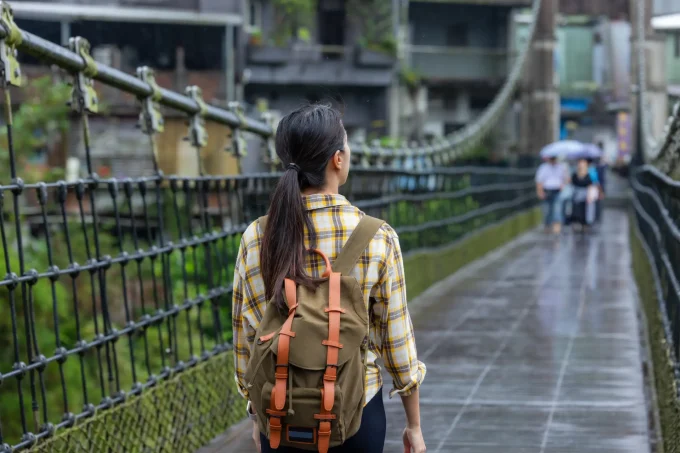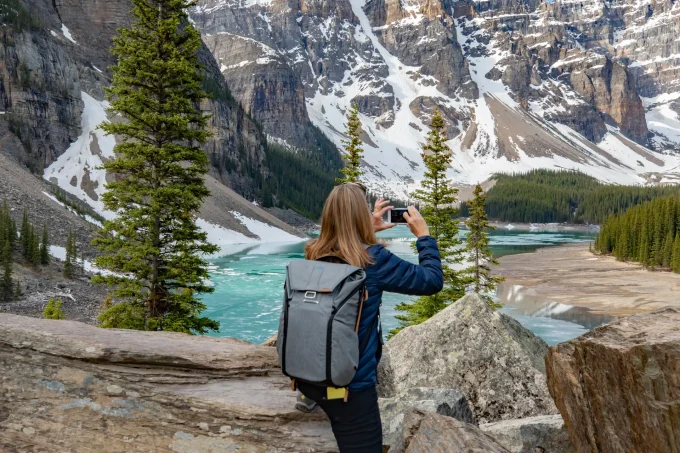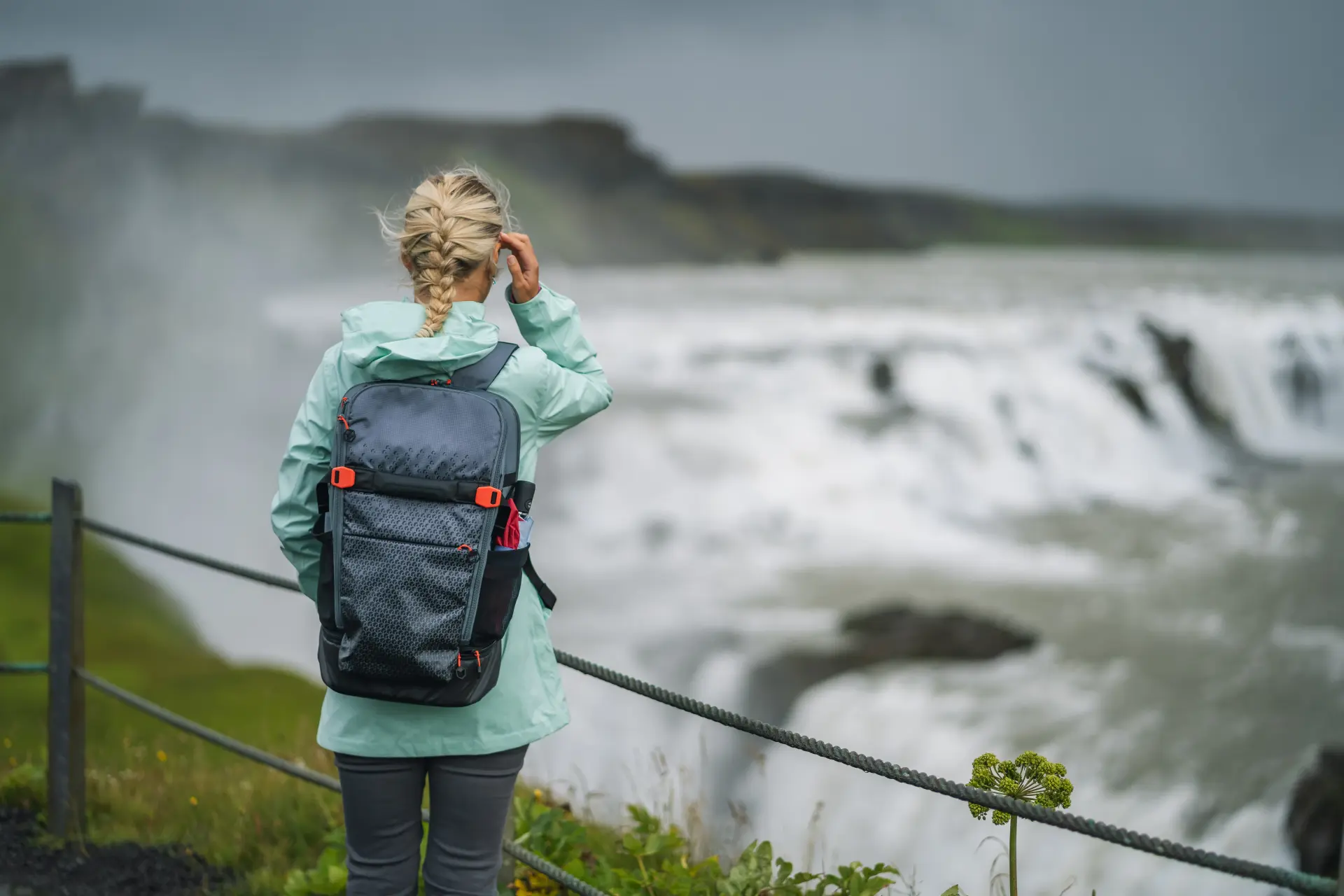If you’re going to be hiking and/or camping, you’re going to need something to carry your personal belongings in. Sure, you can keep your car keys and wallet in your pockets, but what if you’re going on an all-day hike? Exactly. You need yourself a daypack that’ll be able to carry food and small items.
So, before you plan your day trip, you need to have the proper equipment to support you on your journey. So, if you’re asking yourself, “what is a daypack?” don’t worry, we have you covered with everything you need to know.
What is a daypack?
A daypack is essentially a somewhat small backpack, equipped with shoulder straps and a waist belt which you’ll be able to use on hikes or camping adventures. If you’re looking to going on an overnight or multi-day trip, you’ll need a backpack rather than a daypack due to the lack of an internal frame.
With a daypack, you’ll be able to carry a maximum of 20 to 25 pounds. Many daypacks are designed for specific activities or to carry specific gear. Not sure what the difference is between a daypack and backpack? Let’s take a closer look.
When to use a daypack
So, now that you know what a daypack is, when are you going to use it? Daypacks are designed for activities that require you to carry gear, such as hiking to climbing or even more general activities like commuting or traveling. Daypacks are essentially designed to support whatever activity you’re doing, but some are specifically designed to support one activity over the other.
Daypack or backpack?
If you’re trying to figure out what type of travel pack you should buy, it’s important to know the difference so that you can choose one that suits your needs.
Backpack
A backpack is designed to be able to sustain you for overnight and multi-day trips. You’ll be able to go hiking and camping while carrying all your gear in your backpack, hold your sleeping equipment such as a sleeping bag and tent, and carry other supplies such as food and clothing.
See also: Best Solar Backpack: Juicing up your Devices on the Go
Backpacks usually come with a frame or plates which provide you with a sturdy and stable structure to carry your heavy load.
Daypack
A daypack is smaller than a backpack which is designed for activity that lasts about a day. They’re designed with padded shoulder straps to relieve the pressure and provide you with more comfort.
Depending on how much you invest in your daypack, it may come equipped with suspensions and a padded hip belt. However, many daypacks come without these accessories. You’ll be able to carry a day’s worth of supplies, such as food, water, and rain gear.
Now when you know the difference between a daypack and backpack, it’s time for you to learn everything about daypacks.
Types of daypacks
Before you go out and buy a daypack, it’s important to consider what you’re going to be using it for. This daypack will be essential for carrying your gear and supporting you throughout your activity. So, determine what your primary use if for your daypack, that way, you’ll be able to choose a bag which can accommodate your needs.
There are a couple different types of daypacks to choose from depending on what you’re looking for. Let’s take a closer look at your options.
General Daypacks

General daypacks are the most commonly used, as they’re suitable for just about anything. They’re relatively inexpensive and you can use them not only for hiking but for school, work and commuting.
They come with a variety of pockets, so you’ll be able to organize your things, plus, you’re given a lot of storage space. However, if you’re looking for a hiking daypack, these may cause some problems as they tend to lack durability and an internal frame for support.
Hiking Daypacks
Hiking daypacks should be able to support you by carrying all your essentials such as water, food, first aid kit and rain gear. These daypacks are usually built padded shoulder rests and have a capacity of 20 to 30 liters.
Their key features usually include a hydration compartment, side pockets, carrying options for ice axes and poles. For a great hiking daypack, look for one with proper ventilation and extra cushioning. See our guide on how to make a day hike checklist for more information.
Climbing Daypacks
Now, depending on your style of climbing, you’ll want to look for a daypack between 12 to 20 liters – you’ll be able to carry it securely on your back. These daypacks tend to be narrow in design, giving your great motion in your shoulders and arms, while still providing you comfort. Climbing daypacks may also include features such as a daisy chain attachment.
Alpine and Ski Touring Daypacks

If you’re going to be skiing, you’ll need a daypack specifically designed for this activity. These daypacks tend to be larger and able to carry between 20 to 40 pounds and are built for speed as opposed to style.
These bags are narrowly built, with the sternum strap and hip belt included. These daypacks will have a place for you to safely place your ice axe, shovel, probe and crampons. If you’re only skiing, then you’ll be able to find a daypack which will have an area for you to store your skis.
Trail Running Daypacks
These daypacks tend to be smaller than the rest as they’re designed simply to carry your essentials. You won’t need much when you’re running, however, if you’re also planning on using it for hiking, we suggest you opt for a daypack that’s a little larger in size.
Now that you know the types of daypacks available, it’s important to see what features you need to look for.
Features you need to consider in a Quality Daypack
Before you grab the first daypack you see, you need to make sure that it’s equipped with essential features you’ll be needing. Let’s take a closer look at the must-have features in your daypack.
Internal Frame or Framesheet
If you’re going to be getting involved in some serious hiking, you need to make sure you get a daypack which has either an internal frame or a framesheet. A frame/framesheet allows the daypack’s weight to hit on the hips as opposed to the shoulders. It’ll alleviate the pressure from your shoulders and make your journey much easier.
Fabric
Fabric is an essential feature to consider when looking for a daypack that’ll last you a couple years.
- Nylon: This is one of the most commonly used fabrics in daypacks because it can withstand abrasion and tearing. Nylon/polyester blends are also commonly used, however, that’s more for aesthetics.
- Ripstop: Ripstop is either nylon or polyester, however, they’re woven in a specific was which creates a reinforced grid. Ripstop is ideal fabric if you’re prone to tearing your daypacks, hence the name “Ripstop”.
- Kodra: This material uses high-tenacity fibers to create the ultimate abrasion and tear resistant material for daypacks. However, though Kodra is extremely durable, it’s also much heavier than the other materials.
Ventilation
There’s nothing worse than having a back dripping in sweat while carrying your daypack. Not only is it uncomfortable, it can also cause you to develop a heat rash. Most daypacks will use a lightweight frame that’ll push the weight of your daypack away from your back. They’ll have a mesh back panel which also helps to absorb the moisture. This will cause an airflow to reach behind your back. However, if you’re carrying a heavier load, this won’t be ideal for you. But, the only way to test out a daypacks ventilation is to try it on.
- Top-loader vs. Panel-loader: Daypacks usually come in two different loading styles: top-loaders and panel-loaders.
- Top-loaders: Top-loading daypacks are typically lighter and minimalistic in design. They’re similar to the design of a backpacking pack where you place all your gear from one access point. These daypacks are ideal for fast and light hikes.
- Panel-loaders: Panel-loading packs typically have multiple compartments which are ideal if you need to organize your gear. In comparison to top-loaders, these daypacks are much easier to sort through. They’re also more versatile for a variety of activities in comparison to top-loaders.
Capacity
The ideal volume for a daypack ranges between 20 to 30 liters. Now, unless you need a daypack for a specific purpose such as skiing, if you go 30 liters, you’re entering into backpacking sizing which is counterproductive to what you need. In addition, if you go under 20 liters, you’ll also find it hard to fit all your essentials inside. What you’ll need to do is look at what activities you’ll be using your daypack for and then choose a daypack in accordance to that.
Waterproof
Most daypacks do not come with a rain cover, however, many companies do feature them as an additional accessory. Now, this purely depends on what you’ll be using your daypack for, however, rain covers do come in handy if you’re going to be hiking in conditions of humidity and/or rain. Rain covers are able to cover your entire daypack, ensuring that your contents stay completely dry.
Strap Adjustments
You want a daypack that’ll be able to adjust to your body. So, with this being said, keep in mind that the more adjustable straps you have, the better. All daypacks come with adjustable shoulder straps and most also come equipped with adjustable waist straps. You should look for a daypack that comes with riser straps as it helps to alleviate the pressure off of your shoulders.
Hydration Compartment
Whatever the activity, you’re going to get thirsty. You must choose a daypack that either has a hydration bladder or is hydration compatible.
Make sure that your daypack can equip 2-liter or 3-liter water bladders. Hydration bladders are much easier and convenient in comparison to water bottles, plus, they also weigh less.
For the best packable daypack, see our must-read article on this topic.
Other features that you should consider
These features are not necessarily required, however, they will make your experience more enjoyable and less of a hassle. So, if you get a daypack with these features, great. If not, don’t worry, the most important ones are mentioned above.
Organizer Pocket
If you need an organized daypack, look for one with a variety of pockets. It’ll come with different sized internal pockets and sleeves for keeping your small items organized.
Exterior Pockets
Most daypacks will come with a couple exterior pockets, which are helpful when wanting to grab your water bottle or iPhone. You’ll be able to easily access crucial items without having to take off your daypack.
Compression Straps
They’re located on the sides of your daypack and you can use them to tighten your daypack, preventing your items from moving around inside. It’s not completely necessary, however, you do notice a difference when using them.
Laptop Sleeve
Depending what you’re using your daypack for, if you’ll be bringing your laptop with you, look for a daypack with a laptop sleeve. It’s a padded sleeve which will secure and protect your laptop from damage.
Tool Loops
If you’re going to be bringing tools with you, then you’ll need a place to store them. Tool loops will be able to hold your ice axe, trekking poles and other gear.
Wrap Up
Now that you know what a daypack, what types are available and what features you need to look for, it’s time that you went out and tried some on. Remember, you need to look for a daypack which suits your needs. Look at what you’ll be needing your daypack for and narrow your options from there. Check out our tips on how to choose the best daypack for your use.
Make sure you try it on and it fits you comfortably. It’s going to be on your back for a couple hours, so take some in and walk around the store with it on, testing your range of motion. Let us know which daypack you like in the comment section below!

Mark Foster loves to push his limits when it comes to survival in the wilderness. He might go for a 30-days adventure without any food or equipment except for a survival kit and a knife. We should mention that his survival kit has 122 items in it, so he know what he is doing. Mark is working on his book to share with the world all his experience gained during those brave adventures.

What an awesome article Mark! I am planning to buy a daypack but there are so many brands to choose from so I am having a hard time. Now, it is easier because you have listed all the factors that I need to consider. Do you have a specific brand in mind that you can recommend?
Before reading this, I was not familiar with the hydration bladder to be honest because I usually just have a huge bottle with me. The next time that I will buy a daypack I will make sure it has one. I think it will be much easier to carry since they weigh less than regular bottles. Thanks for the tip!
You are welcome! We love that you loved our article! Hope we helped!
I love all of the ones listed in this article. Picking just one is hard, as it usually comes down to preference. Good luck!